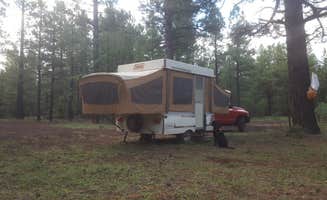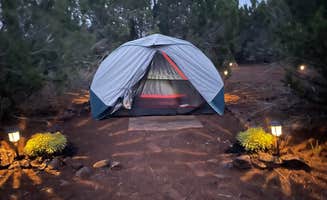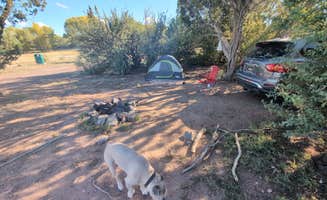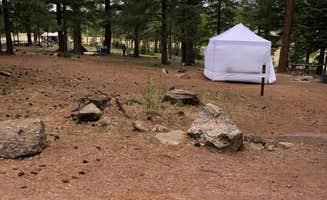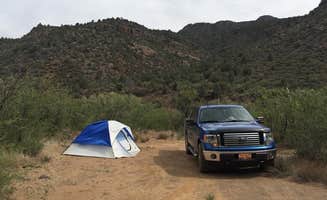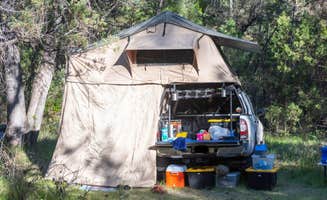Tent camping near Lakeside, Arizona concentrates primarily in the Apache-Sitgreaves National Forest region at elevations around 7,000-8,000 feet, providing significant temperature advantages compared to lower Arizona elevations. The area sits at the southern edge of the Colorado Plateau, characterized by Ponderosa pine forests and volcanic soil conditions. Campsites vary from dispersed options with no facilities to established campgrounds with basic amenities on both national forest and Apache tribal land.
What to do
Fishing access points: Several campgrounds connect directly to fishing opportunities at smaller, less crowded lakes. At Shush Bezahze, campers appreciate the "easy access to lake" with one reviewer noting the campground offers "boondocking at its finest! Quiet, large campground, easy access to lake, wildlife."
Wildlife watching: The higher elevation pine forests support diverse wildlife viewing opportunities from tent sites. Many campers report deer sightings in early mornings and evenings, while bird watching remains productive throughout the day near water sources. According to one camper at Shush Bezahze, the campground provides opportunities for "wildlife" viewing while being "close to town but far enough that it feels like your way out."
Nearby town convenience: Despite the remote forest feeling, tent campers can access supplies in nearby towns within reasonable driving distances. One camper noted that camping locations like Shush Bezahze strike the perfect balance, being "close to town but far enough that it feels like your way out."
What campers like
Secluded forest settings: The relative lack of development appeals to campers seeking genuine forest immersion. A camper at Brown Creek Campground described it as "very secluded and not at all 'developed'" and noted "there are very few fire rings established so plan to build your own."
Dark night skies: The minimal light pollution creates exceptional stargazing opportunities, particularly in remote campgrounds. Brown Creek offers remarkably dark nights, with one camper reporting: "We went on a moonless night and it PITCH BLACK. I know it was overcast but I have to imagine with the amount of tree coverage even a clear night wouldn't be very well lit on the ground."
Natural campsites: Many locations feature minimally altered tent sites amid natural forest conditions. The camping areas often blend into surroundings with limited signage, as one Brown Creek visitor explained: "If you didn't know it was here you wouldn't ever guess there was a campground. The only signage is a 'dead out' fire sign."
What you should know
Tribal permit requirements: Many camping areas near Lakeside require special permits for access, particularly those on Apache tribal lands. Verification of current permit requirements is essential before arrival, as regulations change seasonally. One camper at Cooley Lake Campground discovered access limitations, stating simply: "Tribe members only."
Limited signage: Navigation to campgrounds often involves unmarked forest roads with minimal directional indicators. A visitor to Diamond Creek Number Two Campground reported: "We followed directions via Dyrt map down Indian Rt 61. There were no signs. The road became primitive and once we reached the destination via map, still no signs."
Variable road conditions: Access roads to tent camping areas frequently transition from paved to unimproved surfaces, requiring appropriate vehicle clearance. Road quality changes seasonally, with monsoon rains creating challenging conditions in summer months.
Tips for camping with families
Space limitations: Some campgrounds have constraints on group size and tent arrangements. For family camping at Brown Creek, one reviewer cautioned: "I wouldn't call this ideal for larger groups or units. There were only a few spots where I think you could have parked more than 2 tents or anything larger than a pop up camper."
Bathroom planning: The lack of facilities at many sites requires advance planning for sanitation needs, especially with children. Bring portable toilet options for remote camping locations where no vault toilets exist.
Weather preparedness: Shush-Be-Tou Lake Apache Indian Res and other higher-elevation campgrounds experience significant temperature fluctuations between day and night, requiring appropriate clothing layers for children. Summer afternoon thunderstorms develop quickly, necessitating rain gear and waterproof tent setups.
Tips from RVers
Size restrictions: Most tent camping areas near Lakeside accommodate only smaller recreational vehicles or none at all. Large RVs and trailers face significant limitations on both forest roads and within campgrounds. Brown Creek specifically notes limited space, with a camper reporting sites that couldn't accommodate "anything larger than a pop up camper."
Water access planning: No water hookups exist at tent-focused campgrounds in the region, requiring self-contained water supplies. RV campers should fill tanks before arrival, with limited water sources available primarily at McCoys Bridge Apache Indian Res and similar locations with drinking water facilities.
Generator policies: Most tent camping areas prohibit generator use to maintain natural quiet. RV campers relying on electricity should plan accordingly with solar options or battery capacity for their stay duration.


